El Banco de San Luis Potosí
There was an early attempt to establish a bank when, on 7 October 1889, a concession was granted to Manuel Saavedra and the company that he was organisingThe bank would have its domicile in San Luis Potosí and could establish branches and agencies in the towns that were suitable for the development of their activities in the states of San Luis Potosí, Zacatecas, Nuevo León and Tamaulipas. It could issue banknotes for an amount equal to a third of its capital displayed in cash. The bank's share capital would be at least 500,000 pesos divided into shares of one hundred pesos each. The contract would last for fifty years from the date on which it was signed. but it was unable to raise the necesary deposit of $30,000 in bonds within the six months time-limit and the contract was declared void.
In May 1897, Matías Hernández Soberón, Gerardo and Eduardo Meade, Ramón Alcázar, Donato de Chapeaurouge and the firms J. H. Bahnsen y Cía., Rivero y LiañoThe partners in the Compañía Rivero y Liaño were the Spaniards Manuel Rivero Soberón and Celso Liaño. Manuel, who managed the business, was a cousin of Matías Hernández Soberón, who called himself a merchant, although he also invested in other economic activities such as mining and agriculture. When the partnership was formalized, Celso Liaño was also engaged independently in the sale of articles for clothing in the Potosi capital. Celso owned real estate in Monterrey and had shares in mining companies such as the Negociación Minera de Azogue La Trinidad and Negociación Minera El Nuevo Potosí, located in Guadalcázar, San Luis Potosí. He was also a shareholder of the Empresa de Aguas of the city of San Luis Potosi. Likewise, their casa comercial were shareholders in mining companies such as in the Negociación Minera de Berrones y Aurrecoechea of Zacatecas, along with Daniel Aresti, Felipe Muriedas and Tomás Olavarría., Aresti y Cía., and Hugo Scherer y Cía., formed an association to gain the concession for a bank of issue in San Luis Potosí. They nominated Gerardo and Eduardo Meade, J. H. Bahnsen y Cía. and Ramón Alcázar to negotiate with the Secretaría de HaciendaASLP, RPPC, Jesús Hernández Soto, inscrip. 267, 14 October 1897. The concession was granted on 15 June 1897Diario de la Federación, 15 June 1897, its conditions satisfied on 15 September and President Diaz gave his approval on 24 September.
These people were already involved in some form of banking. In 1889, the Trades Directory listed a “Banco Matías Hernández Soberón”, a “Banco Ignacio Muriel” and a “Banco Aresti y Compañía” (the firm to which Tomás Olavarría belonged).
The initial capital was $500,000, which increased almost immediately to $1,100,000. The shareholders were Mexicans such as Hernández Soberón, Meade, Ribero, Liaño and Olavarría among others, as well as foreigners from the area. To be a member of the board, one had to be from San Luis Potosí or Guanajuato and hold at least 50 shares of $1,000 apiece.
The bank took a ten year lease on 1a calle de Hidalgo núm. 2 and opened to the public on 15 OctoberMemorias de las Instituciones de Crédito correspondientes á los años de 1897-1899, tomo II.
The first board, chosen on 4 October, were Hernández Soberón, presidente; Eduardo Meade, vicepresidente; Guillermo R. Peterson (a partner in Bahnsen y Cía.) primer vocal; Tomás Olavarría (an old partner of Aresti y Cía.), segundo vocal; Manuel Rivero Soberón (partner and manager of Rivero y Liaño), tercer vocal; Enrique Schroeder (partner in Bahnsen y Cía.) comisario propietario, and Pedro Barrenechea, comisario suplente ASLP, RPPC, Jesús Hernández Soto, inscrip. 267, 14 de octubre de 1897. Thereafter the board demonstrated a remarkable continuity, with family networks and successions.
The bank established a branch in León, Guanajuato on 28 February 1898Memorias de las Instituciones de Crédito correspondientes á los años de 1897-1899, tomo II. It then established an agency to exchange its notes in Celaya, which became a branch on 3 December 1898ibid.. These branches were governed by juntas de administración; that of León originally was composed of Ramón Alcázar, presidente; Enrique R. González, primer vocal; Emilio Bitrolff, segundo vocal; Andrés Pfeiffer, manager (gerente) and Rafael Villalobos, as cajero contador. In Celaya the junta was Agustín González, presidente; Eusebio González, primer vocal; Juan D. Argomedo, segundo vocal and Germán Koenige, as manager.
Matías Hernández Soberón, who had been presidente since the foundation, died in March 1907 and was succeeded by Meade.
In July 1902 Eduardo Meade, vicepresidente of the Banco de San Luis Potosí, represented by his brother Gerardo, and Guillermo R. Peterson, Tomás Olavarría y Compañía S.C., Mariano Hernández Ceballos and Eugenio Labarthe, lawyer of Camilo Vallejo of Aguascalientes, formed a company to establish El Banco de AguascalientesASLP, RPPC, Jesús Hernández Soto, prot. 1902, insc. 2, “Constitución del Banco de Aguascalientes”, 2 July 1902.
The last general meeting of the bank took place in San Luis Potosí on 2 May 1914, by which time the office had moved provisionally to Mexico City.
The Comisión Reguladora e Inspectora de Instituciones de Crédito decreed the bank's bankruptcy on 4 December 1915. In response the bank called a meeting for 14 November 1916 but there were not enough members. It met on 22 December with Olavarría in the chair and Mariano Hernández Ceballos, Eugenio Labarthe, Mariano Hernández Toranzo, Rafael Villalobos, Deogracias Alonso, William Dickson, and G. Amsinck y Cía., among other shareholders, present. The Consejo de Incautación presented himself in the offices on 2 January 1917 and dismissed the manager and board. The bank was finally liquidated in 1921.
American Bank Note Company print runs
The American Bank Note Company produced the following notes. It engraved the portrait of Mariano AristaJosé Mariano Martín Buenaventura Ignacio Nepomuceno García de Arista Nuez was born in San Luis Potosí on 26 July 1802. He was a noted veteran of many of Mexico’s wars, fighting under Iturbide and Santa Anna, and against the Texans in 1836 and Americans in 1846 -1848. He was a dedicated republican, and therefore opposed and ill-served in the last campaign by his largely conservative general staff. After his defeats at Palo Alto and Resaca de la Palma he was recalled but absolved of guilt at a subsequent court-martial. On 15 January 1851 he succeeded José Joaquín Herrera as president of Mexico but conservative resistance and an eventual revolt by the conservatives led to his resignation on 6 January 1853. He retired to his hacienda in Anacamilpa, but due to Santa Anna’s constant incursions, he was obliged to abandon it. A very sick man, he then left the country to reside in Seville, Spain. He died aboard the English steamer Tagus on 7 August 1855 during the trip to France in search of a remedy for his illness. (C 217) and the state's coat of arms (C 645).
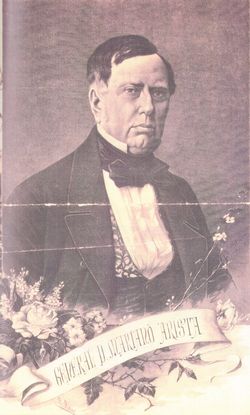 Originally the serial letter A was engraved on the face plates.
Originally the serial letter A was engraved on the face plates.
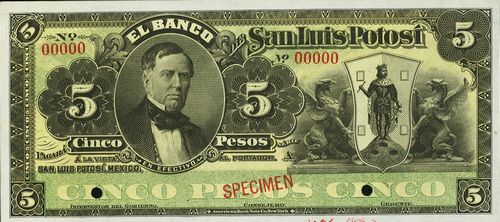
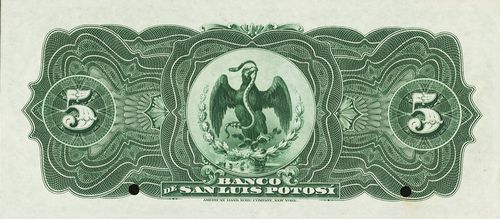
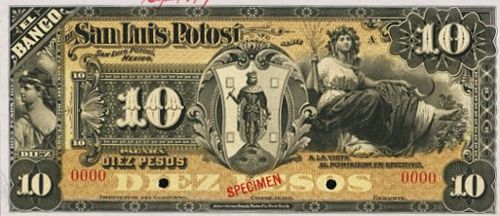
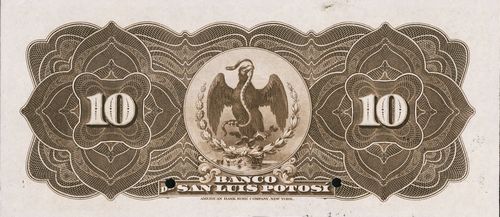
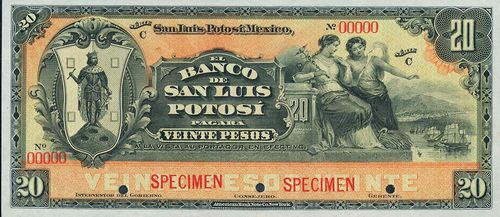
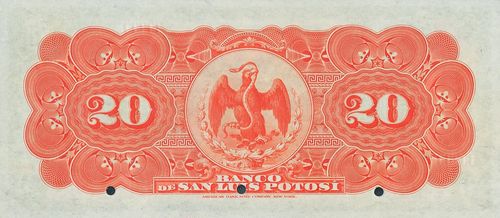
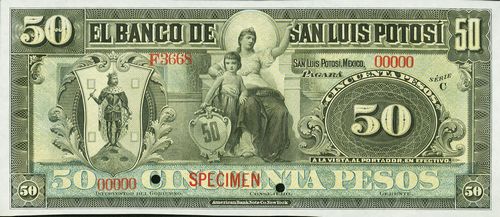

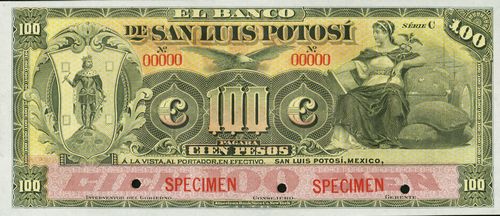
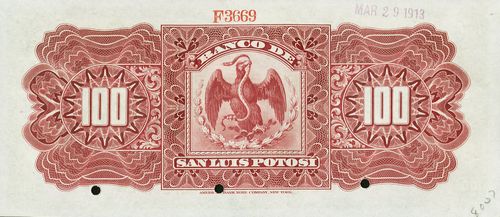
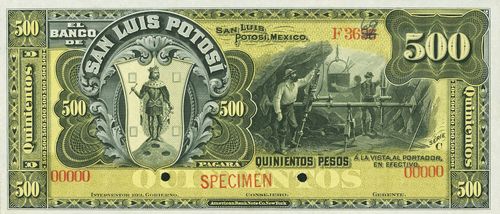
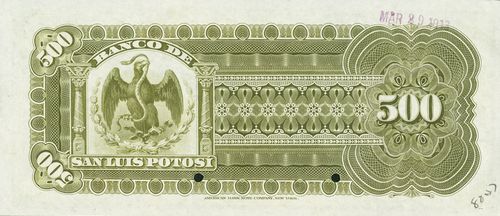
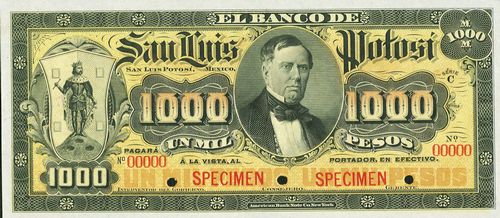
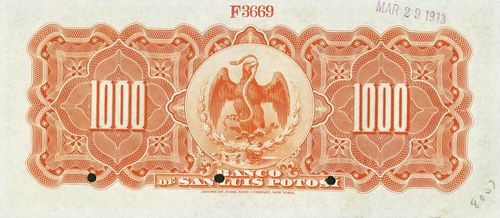
| Date | Value | Number | Series | from | to |
| August 1897 | $5 | 40,000 | A | 1 | 40000 |
| $10 | 35,000 | A | 1 | 35000 | |
| $20 | 16,000 | A | 1 | 16000 | |
| $50 | 4,400 | A | 1 | 4400 | |
| $100 | 2,100 | A | 1 | 2100 | |
| $500 | 200 | A | 1 | 200 | |
| $1000 | 100 | A | 1 | 100 |
| Date | Value | Number | Series | from | to |
| February 1900 | $100 | 500 | A | 2101 | 2600 |
| $500 | 100 | A | 201 | 300 | |
| $1000 | 50 | A | 101 | 150 |
For the August 1900 print run the series letter was erased.
| Date | Value | Number | Series | from | to |
| August 1900 | $5 | 25,000 | B | 40001 | 65000 |
| $10 | 27,500 | B | 35001 | 62500 | |
| $20 | 20,000 | B | 16001 | 36000 | |
| $50 | 5,000 | B | 4401 | 9400 | |
| $100 | 3,000 | B | 2601 | 5600 | |
| $500 | 300 | B | 301 | 600 | |
| $1000 | 150 | B | 151 | 300 |
On 15 March 1913 the bank’s agents in New York, G. Amsinck & Co., wrote to the ABNC enquiring about a proposed order of 92,100 notes in seven denominationsABNC, folder 743, Banco de San Luis Potosí (1913-1931). The ABNC felt that it needed to lay down new $10, $20 and $50 face plates and a $10 back plate, but gave its price on 27 March which was accepted by Amsinck & Co. on the same day.
| Date | Value | Number | Series | from | to |
| March 1913 | $5 | 40,000 | C | 65001 | 105000 |
| $10 | 30,000 | C | 62501 | 92500 | |
| $20 | 15,000 | C | 36001 | 51000 | |
| $50 | 4,000 | C | 9401 | 13400 | |
| $100 | 2,500 | C | 5601 | 8100 | |
| $500 | 400 | C | 601 | 1000 | |
| $1000 | 200 | C | 301 | 500 |
The ABNC shipped the whole order, via the steamer "Esperanza" on 26 June.
On 31 July 1931 Charles T Blackmore, Resident Agent of the American Bank Note Company in Mexico City, wrote to the bank, care of the Comité Liquidador, asking whether it was convenient to destroy the plates. The Comité answered on 7 AugustAGN, Fondo Comisión Monetaria/Antiguos Bancos de Emisión, caja 301 and the plates were destroyed on 28 October 1931These were:
1 – 6 on 5 pesos face plate made on order 8/17/97
1 – 6 on 5 pesos back plate made on order 8/17/97
2 – 1 on 5 pesos tints Nos. 1 & 2 made on order 8/17/97
1 – 4 on 10 pesos face plate #2 made on order F 3667
1 – 4 on 10 pesos back plate #2 made on order F 3667
2 – 1 on 10 pesos tints Nos. 1 & 2 made on order 8/17/97
1 – 4 on 20 pesos face plate #2 made on order F 3667
1 – 4 on 20 pesos back plate made on order 8/17/97
2 – 1 on 20 pesos tints Nos. 1 & 2 made on order 8/17/97
1 – 2 on 50 pesos face plate #2 made on order F 3668
1 – 2 on 50 pesos back plate made on order 8/17/97
2 – 1 on 50 pesos tints Nos. 1 & 2 made on order 8/17/97
1 – 1 on 100 pesos face plate made on order 8/17/97
1 – 1 on 100 pesos back plate made on order 8/17/97
2 – 1 on 100 pesos tints Nos. 1 & 2 made on order 8/17/97
1 – 1 on 500 pesos face plate made on order 8/17/97
1 – 1 on 500 pesos back plate made on order 8/17/97
2 – 1 on 500 pesos tints Nos. 1 & 2 made on order 8/17/97
1 – 1 on 1000 pesos face plate made on order 8/17/97
1 – 1 on 1000 pesos back plate made on order 8/17/97
2 – 1 on 1000 pesos tints Nos. 1 & 2 made on order 8/17/97.
